Best Practice Forever? Dynamics behind the Perception of Farm-Fed Anaerobic Digestion Plants in Rural Peripheries
Abstract
:1. Introduction
2. Conceptual Background
2.1. Special Features of Anaerobic Digestion Plants in Post-Socialist Eastern Europe
2.2. Factors Affecting the Perception of Anaerobic Digestion Plants
- The intensity and relevance of how residents were informed of the planned construction of an AD plant;
- The possibilities for participating in the planning process of an AD plant;
- Active participation in the planning process of an AD plant;
- Conflict situations resulting from the operation of an AD plant.
3. Materials and Methods
3.1. Study Area
3.2. Data Collection and Questionnaire
3.3. Data Analyses
4. Results
5. Discussion
6. Conclusions
Supplementary Materials
Author Contributions
Funding
Institutional Review Board Statement
Informed Consent Statement
Data Availability Statement
Acknowledgments
Conflicts of Interest
References
- Scarlat, N.; Dallemand, J.F.; Fahl, F. Biogas: Developments and perspectives in Europe. Renew. Energy 2018, 129, 457–472. [Google Scholar] [CrossRef]
- Carvalho, M.D. EU energy and climate change strategy. Energy 2012, 40, 19–22. [Google Scholar] [CrossRef]
- Lucas, J.N.V.; Frances, G.E.; Gonzalez, E.S. Energy security and renewable energy deployment in the EU: Liaisons Dangereuses or Virtuous Circle? Renew. Sustain. Energy Rev. 2016, 62, 1032–1046. [Google Scholar] [CrossRef]
- Frantal, B.; Novakova, E. On the spatial differentiation of energy transitions: Exploring determinants of uneven wind energy developments in the Czech Republic. Morav. Geogr. Rep. 2019, 27, 79–91. [Google Scholar] [CrossRef] [Green Version]
- Van der Horst, D.; Martinat, S.; Navratil, J.; Dvorak, P.; Chmielova, P. What can the location of biogas plants tell us about agricultural change? A Case Study from the Czech Republic. Deturope-Cent. Eur. J. Reg. Dev. Tour. 2018, 10, 33–52. [Google Scholar] [CrossRef]
- Chodkowska-Miszczuk, J.; Martinat, S.; Kulla, M.; Novotny, L. Renewables projects in peripheries: Determinants, challenges and perspectives of biogas plants—Insights from Central European countries. Reg. Stud. Reg. Sci. 2020, 7, 362–381. [Google Scholar] [CrossRef]
- Martinat, S.; Navratil, J.; Dvorak, P.; Van der Horst, D.; Klusacek, P.; Kunc, J.; Frantal, B. Where AD plants wildly grow: The spatio-temporal diffusion of agricultural biogas production in the Czech Republic. Renew. Energy 2016, 95, 85–97. [Google Scholar] [CrossRef]
- Chodkowska-Miszczuk, J.; Kulla, M.; Novotny, L. Biogas energy—A chance for agriculture and rural development? Insight from the post-communist Central Europe. Deturope-Cent. Eur. J. Reg. Dev. Tour. 2019, 11, 30–53. [Google Scholar] [CrossRef]
- van der Ploeg, J.D.; Renting, H.; Brunori, G.; Knickel, K.; Mannion, J.; Marsden, T.; de Roest, K.; Sevilla-Guzman, E.; Ventura, F. Rural development: From practices and policies towards theory. Sociol. Rural. 2000, 40, 391–408. [Google Scholar] [CrossRef]
- Renting, H.; Rossing, W.A.H.; Groot, J.C.J.; Van der Ploeg, J.D.; Laurent, C.; Perraud, D.; Stobbelaar, D.J.; Van Ittersum, M.K. Exploring multifunctional agriculture. A review of conceptual approaches and prospects for an integrative transitional framework. J. Environ. Manag. 2009, 90, S112–S123. [Google Scholar] [CrossRef]
- Jenssen, T.; Konig, A.; Eltrop, L. Bioenergy villages in Germany: Bringing a low carbon energy supply for rural areas into practice. Renew. Energy 2014, 61, 74–80. [Google Scholar] [CrossRef]
- Dincer, I. Renewable energy and sustainable development: A crucial review. Renew. Sustain. Energy Rev. 2000, 4, 157–175. [Google Scholar] [CrossRef]
- Zemo, K.H.; Panduro, T.E.; Termansen, M. Impact of biogas plants on rural residential property values and implications for local acceptance. Energy Policy 2019, 129, 1121–1131. [Google Scholar] [CrossRef]
- Chodkowska-Miszczuk, J.; Martinat, S.; Cowell, R. Community tensions, participation, and local development: Factors affecting the spatial embeddedness of anaerobic digestion in Poland and the Czech Republic. Energy Res. Soc. Sci. 2019, 55, 134–145. [Google Scholar] [CrossRef]
- Chodkowska-Miszczuk, J.; Martinat, S.; van der Horst, D. Changes in feedstocks of rural anaerobic digestion plants: External drivers towards a circular bioeconomy. Renew. Sustain. Energy Rev. 2021, 148, 111344. [Google Scholar] [CrossRef]
- Martinat, S.; Dvorak, P.; Frantal, B.; Klusacek, P.; Kunc, J.; Kulla, M.; Mintalova, T.; Navratil, J.; Van der Horst, D. Spatial consequences of biogas production and agricultural changes in the Czech Republic after EU accession: Mutual symbiosis, coexistence or parasitism? Acta Univ. Palacki. Olomuc. Fac. Rerum Nat. Geogr. 2013, 44, 75–92. [Google Scholar]
- Ciervo, M.; Schmitz, S. Sustainable biofuel: A question of scale and aims. Morav. Geogr. Rep. 2017, 25, 220–233. [Google Scholar] [CrossRef] [Green Version]
- Frantal, B.; Prousek, A. It’s not right, but we do it. Exploring why and how Czech farmers become renewable energy producers. Biomass Bioenergy 2016, 87, 26–34. [Google Scholar] [CrossRef]
- Upreti, B.R.; van der Horst, D. National renewable energy policy and local opposition in the UK: The failed development of a biomass electricity plant. Biomass Bioenergy 2004, 26, 61–69. [Google Scholar] [CrossRef]
- Kortsch, T.; Hildebrand, J.; Schweizer-Ries, P. Acceptance of biomass plants—Results of a longitudinal study in the bioenergy-region Altmark. Renew. Energy 2015, 83, 690–697. [Google Scholar] [CrossRef]
- Martinat, S.; Dvorak, P.; Navratil, J.; Klusacek, P.; Kulla, M.; Mintalova, T.; Martinatova, I. Importance of agricultural anaerobic digestion plants for agriculture and rural development: Notes on researches carried out in the Czech Republic and Slovakia. Rural Dev. 2013, 6, 168–176. [Google Scholar]
- Chodkowska-Miszczuk, J.; Kola-Bezka, M.; Lewandowska, A.; Martinat, S. Local Communities’ Energy Literacy as a Way to Rural Resilience-An Insight from Inner Peripheries. Energies 2021, 14, 2575. [Google Scholar] [CrossRef]
- Dvorak, P.; Martinat, S.; Van der Horst, D.; Frantal, B.; Tureckova, K. Renewable energy investment and job creation; a cross-sectoral assessment for the Czech Republic with reference to EU benchmarks. Renew. Sustain. Energy Rev. 2017, 69, 360–368. [Google Scholar] [CrossRef] [Green Version]
- Martinat, S.; Melnikova, V.; Dvorak, P.; Klusacek, P.; Navratil, J.; Van der Horst, D. Anaerobic digestion plants in rural space: Some comments on their acceptance at community level. In Proceedings of the 16th International Colloquium on Regional Sciences, Valtice, Czech Republic, 19–21 June 2013; pp. 287–296. [Google Scholar] [CrossRef]
- Dvorak, P.; Martinat, S.; Klusacek, P.; Van der Horst, D.; Navratil, J.; Kulla, M. Divergent trends in agriculture and in sector of anaerobic digestion plants in the czech republic: Opportunity or threat? In Proceedings of the 16th International Colloquium on Regional Sciences, Valtice, Czech Republic, 19–21 June 2013; pp. 277–286. [Google Scholar] [CrossRef]
- Martinat, S.; Navratil, J.; Trojan, J.; Frantal, B.; Klusacek, P.; Pasqualetti, M.J. Interpreting regional and local diversities of the social acceptance of agricultural AD plants in the rural space of the Moravian-Silesian Region (Czech Republic). Rend. Lincei-Sci. Fis. E Nat. 2017, 28, 535–548. [Google Scholar] [CrossRef] [Green Version]
- Wustenhagen, R.; Wolsink, M.; Burer, M.J. Social acceptance of renewable energy innovation: An introduction to the concept. Energy Policy 2007, 35, 2683–2691. [Google Scholar] [CrossRef] [Green Version]
- Acikgoz, C. Renewable energy education in Turkey. Renew. Energy 2011, 36, 608–611. [Google Scholar] [CrossRef]
- Magnani, N. Exploring the Local Sustainability of a Green Economy in Alpine Communities. Mt. Res. Dev. 2012, 32, 109–116. [Google Scholar] [CrossRef]
- Dobers, G.M. Acceptance of biogas plants taking into account space and place. Energy Policy 2019, 135, 110987. [Google Scholar] [CrossRef]
- Emmann, C.H.; Arens, L.; Theuvsen, L. Individual acceptance of the biogas innovation: A structural equation model. Energy Policy 2013, 62, 372–378. [Google Scholar] [CrossRef]
- Soland, M.; Steimer, N.; Walter, G. Local acceptance of existing biogas plants in Switzerland. Energy Policy 2013, 61, 802–810. [Google Scholar] [CrossRef]
- Kontogianni, A.; Tourkolias, C.; Skourtos, M.; Damigos, D. Planning globally, protesting locally: Patterns in community perceptions towards the installation of wind farms. Renew. Energy 2014, 66, 170–177. [Google Scholar] [CrossRef]
- Hadar, L.; Danziger, S.; Hertwig, R. The Attraction Effect in Experience-based Decisions. J. Behav. Decis. Mak. 2018, 31, 461–468. [Google Scholar] [CrossRef] [Green Version]
- McAndrew, C.; Gore, J. Understanding Preferences in Experience-Based Choice: A Study of Cognition in the “Wild”. J. Cogn. Eng. Decis. Mak. 2013, 7, 179–197. [Google Scholar] [CrossRef] [Green Version]
- OWR. Rejestr Wytwórców Biogazu Rolniczego. Available online: https://www.kowr.gov.pl/uploads/pliki/oze/biogaz/Rejestr%20wytw%C3%B3rc%C3%B3w%20biogazu%20rolniczego%20z%20dnia%2028.01.2022%20r.pdf (accessed on 5 February 2022).
- Francis, J.J.; Johnston, M.; Robertson, C.; Glidewell, L.; Entwistle, V.; Eccles, M.P.; Grimshaw, J.M. What is an adequate sample size? Operationalising data saturation for theory-based interview studies. Psychol. Health 2010, 25, 1229–1245. [Google Scholar] [CrossRef] [PubMed] [Green Version]
- Kim, J.H.; Park, J.H.; Yoo, S.H. Public preference toward an energy transition policy: The case of South Korea. Environ. Sci. Pollut. Res. 2020, 27, 45965–45973. [Google Scholar] [CrossRef] [PubMed]
- Bertsch, V.; Hall, M.; Weinhardt, C.; Fichtner, W. Public acceptance and preferences related to renewable energy and grid expansion policy: Empirical insights for Germany. Energy 2016, 114, 465–477. [Google Scholar] [CrossRef]
- Tsagarakis, K.P.; Mavragani, A.; Jurelionis, A.; Prodan, I.; Andrian, T.; Bajare, D.; Korjakins, A.; Magelinskaite-Legkauskiene, S.; Razvan, V.; Stasiuliene, L. Clean vs. Green: Redefining renewable energy. Evidence from Latvia, Lithuania, and Romania. Renew. Energy 2018, 121, 412–419. [Google Scholar] [CrossRef]
- TIBCO. TIBCO Statistica™ Quick Reference. Available online: https://docs.tibco.com/pub/stat/13.3.0/doc/pdf/TIB_stat_13.3_quick_ref.pdf (accessed on 11 December 2021).
- Bremond, U.; Bertrandias, A.; Steyer, J.P.; Bernet, N.; Carrere, H. A vision of European biogas sector development towards 2030: Trends and challenges. J. Clean. Prod. 2021, 287, 125065. [Google Scholar] [CrossRef]
- Bessette, D.L.; Mills, S.B. Farmers vs. lakers: Agriculture, amenity, and community in predicting opposition to United States wind energy development. Energy Res. Soc. Sci. 2021, 72, 101873. [Google Scholar] [CrossRef]
- Stober, D.; Suskevics, M.; Eiter, S.; Muller, S.; Martinat, S.; Buchecker, M. What is the quality of participatory renewable energy planning in Europe? A comparative analysis of innovative practices in 25 projects. Energy Res. Soc. Sci. 2021, 71, 101804. [Google Scholar] [CrossRef]
- Larsen, S.V.; Hansen, A.M.; Nielsen, H.N. The role of EIA and weak assessments of social impacts in conflicts over implementation of renewable energy policies. Energy Policy 2018, 115, 43–53. [Google Scholar] [CrossRef] [Green Version]
- Hewitt, R.J.; Bradley, N.; Compagnucci, A.B.; Barlagne, C.; Ceglarz, A.; Cremades, R.; McKeen, M.; Otto, I.M.; Slee, B. Social Innovation in Community Energy in Europe: A Review of the Evidence. Front. Energy Res. 2019, 7, 31. [Google Scholar] [CrossRef] [Green Version]
- Yildiz, O.; Rommel, J.; Debor, S.; Holstenkamp, L.; Mey, F.; Muller, J.R.; Radtke, J.; Rognli, J. Renewable energy cooperatives as gatekeepers or facilitators? Recent developments in Germany and a multidisciplinary research agenda. Energy Res. Soc. Sci. 2015, 6, 59–73. [Google Scholar] [CrossRef]
- Herbes, C.; Brummer, V.; Rognli, J.; Blazejewski, S.; Gericke, N. Responding to policy change: New business models for renewable energy cooperatives—Barriers perceived by cooperatives’ members. Energy Policy 2017, 109, 82–95. [Google Scholar] [CrossRef]
- Heras-Saizarbitoria, I.; Saez, L.; Allur, E.; Morandeira, J. The emergence of renewable energy cooperatives in Spain: A review. Renew. Sustain. Energy Rev. 2018, 94, 1036–1043. [Google Scholar] [CrossRef]
- Fischer, B.; Gutsche, G.; Wetzel, H. Who wants to get involved? Determining citizen willingness to participate in German renewable energy cooperatives. Energy Res. Soc. Sci. 2021, 76, 102013. [Google Scholar] [CrossRef]
- Nevzorova, T.; Kutcherov, V. Barriers to the wider implementation of biogas as a source of energy: A state-of-the-art review. Energy Strategy Rev. 2019, 26, 100414. [Google Scholar] [CrossRef]
- Benediktsson, K. Conflicting imaginaries in the energy transition? Nature and renewable energy in Iceland. Morav. Geogr. Rep. 2021, 29, 88–100. [Google Scholar] [CrossRef]
- Gnatiuk, O.; Mezentsev, K.; Provotar, N. From the agricultural station to a luxury village? Changing and ambiguous everyday practices in the suburb of Vinnytsia (Ukraine). Morav. Geogr. Rep. 2021, 29, 202–216. [Google Scholar] [CrossRef]
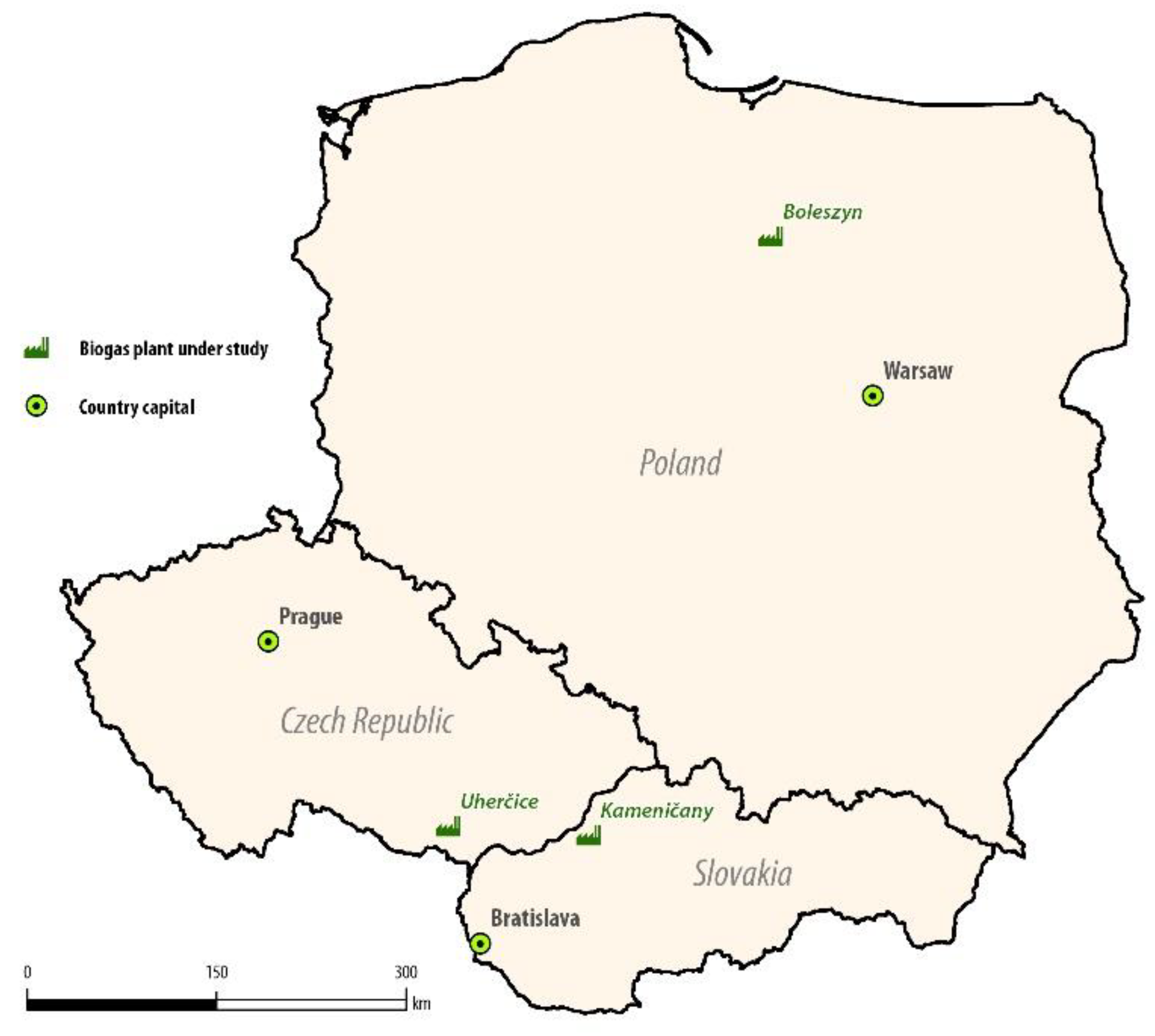
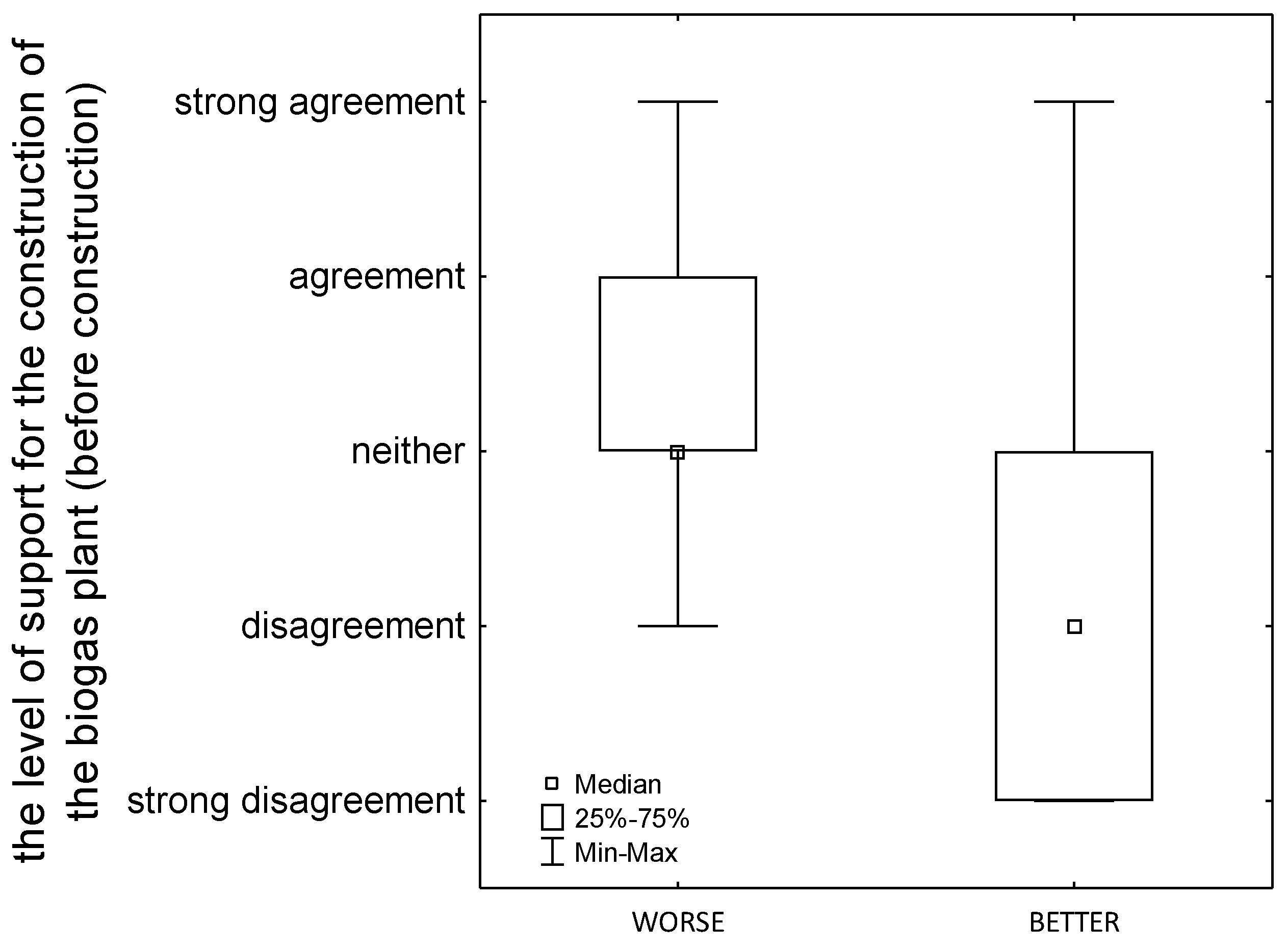
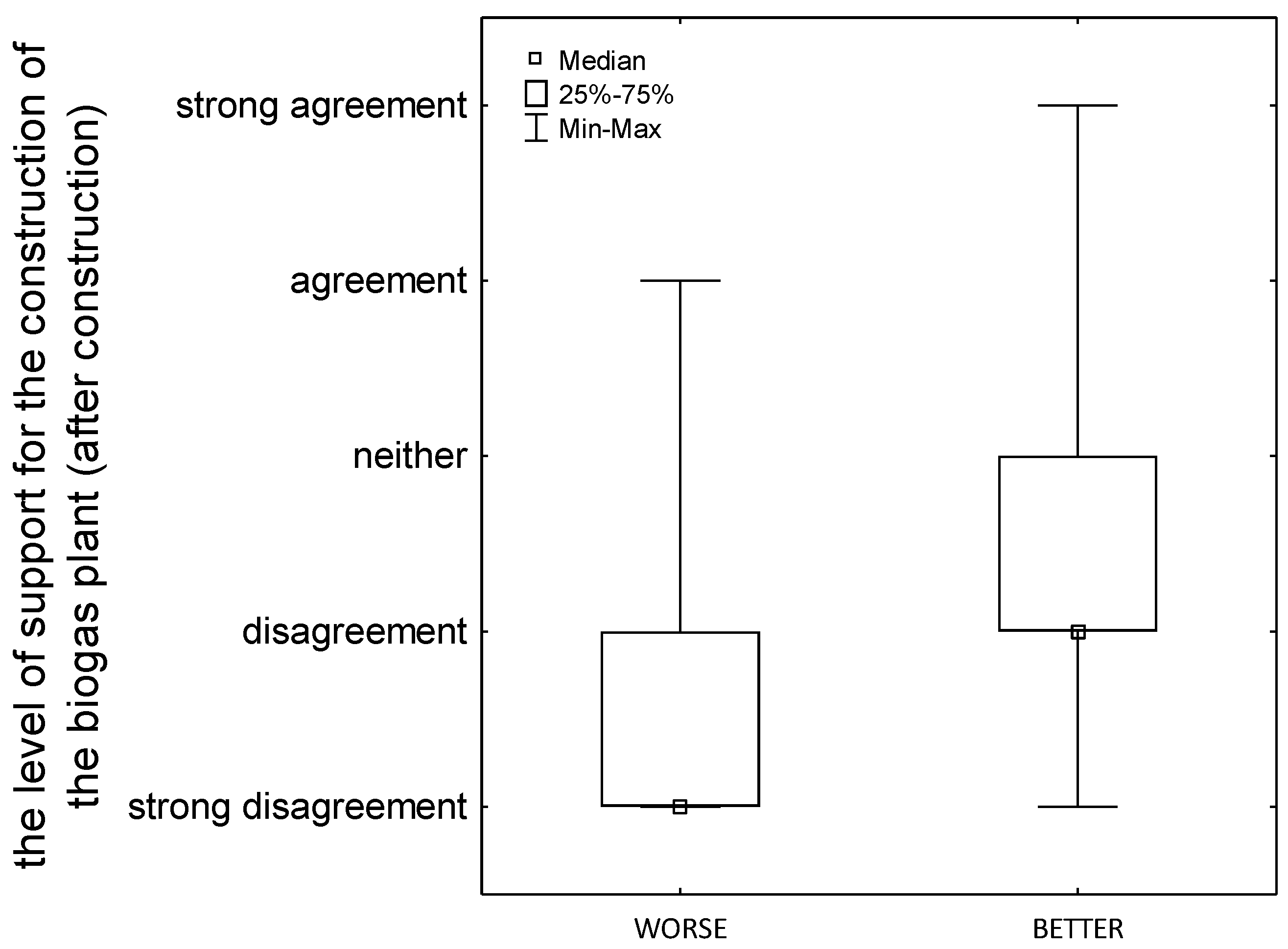
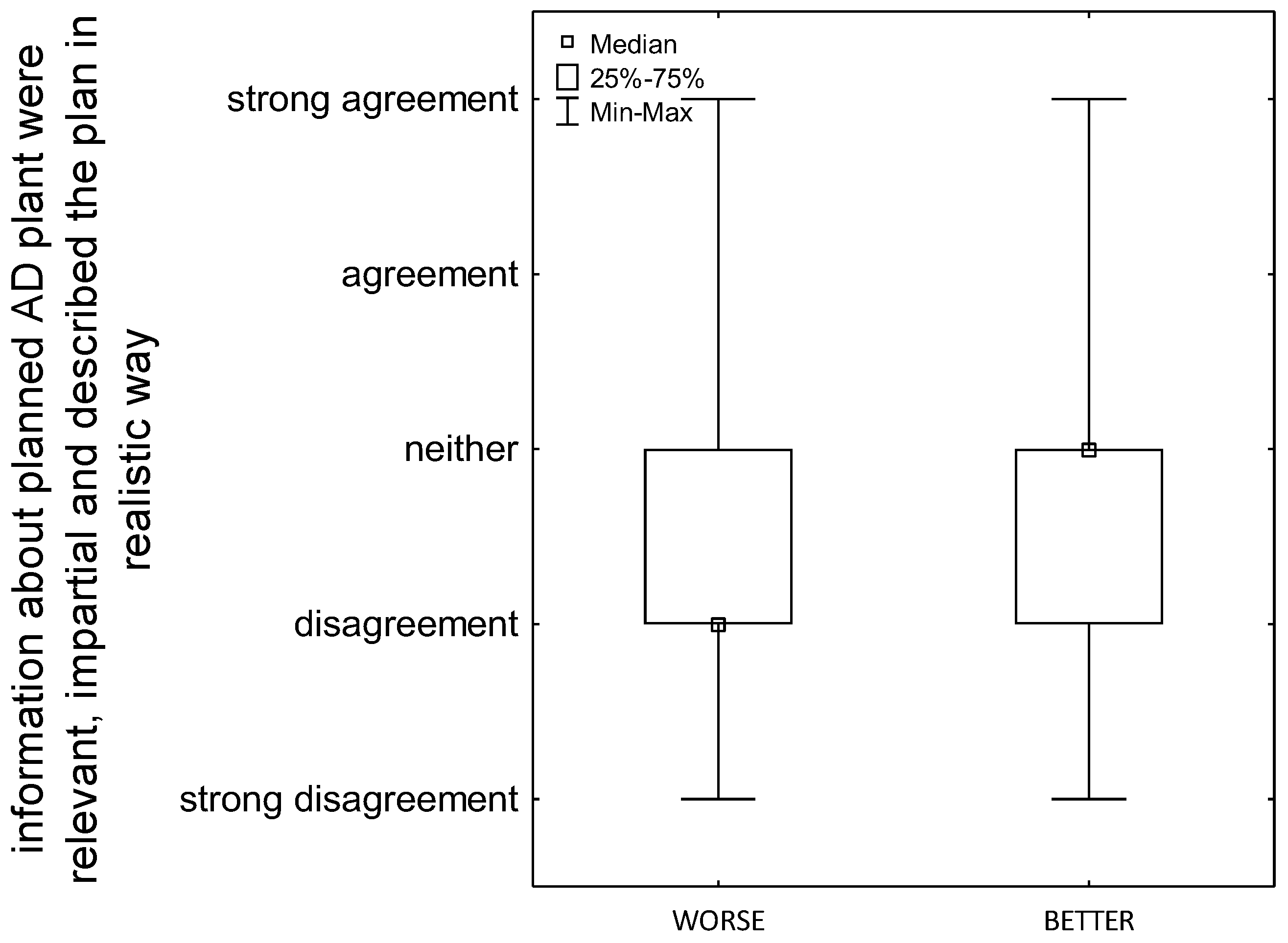
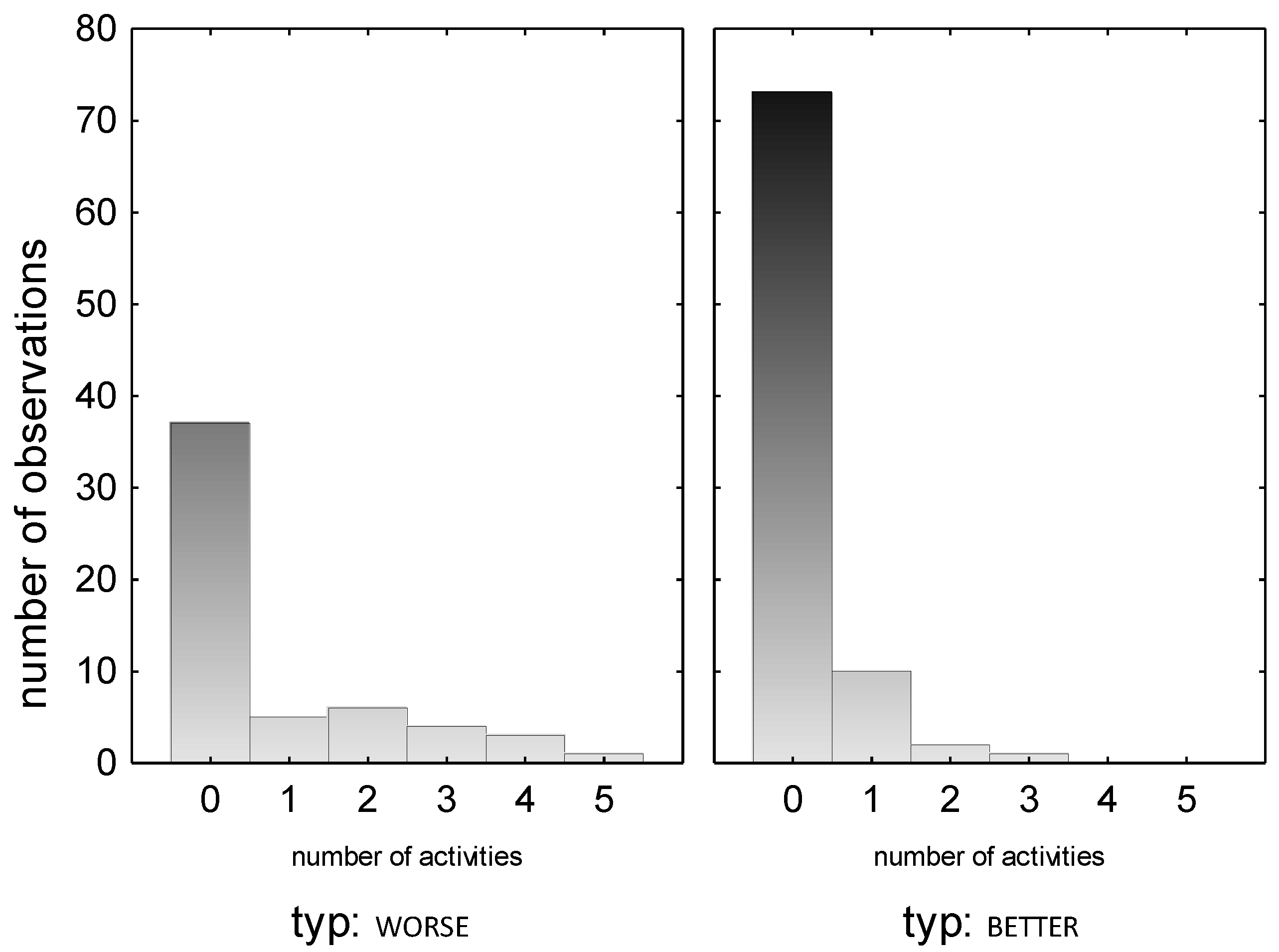
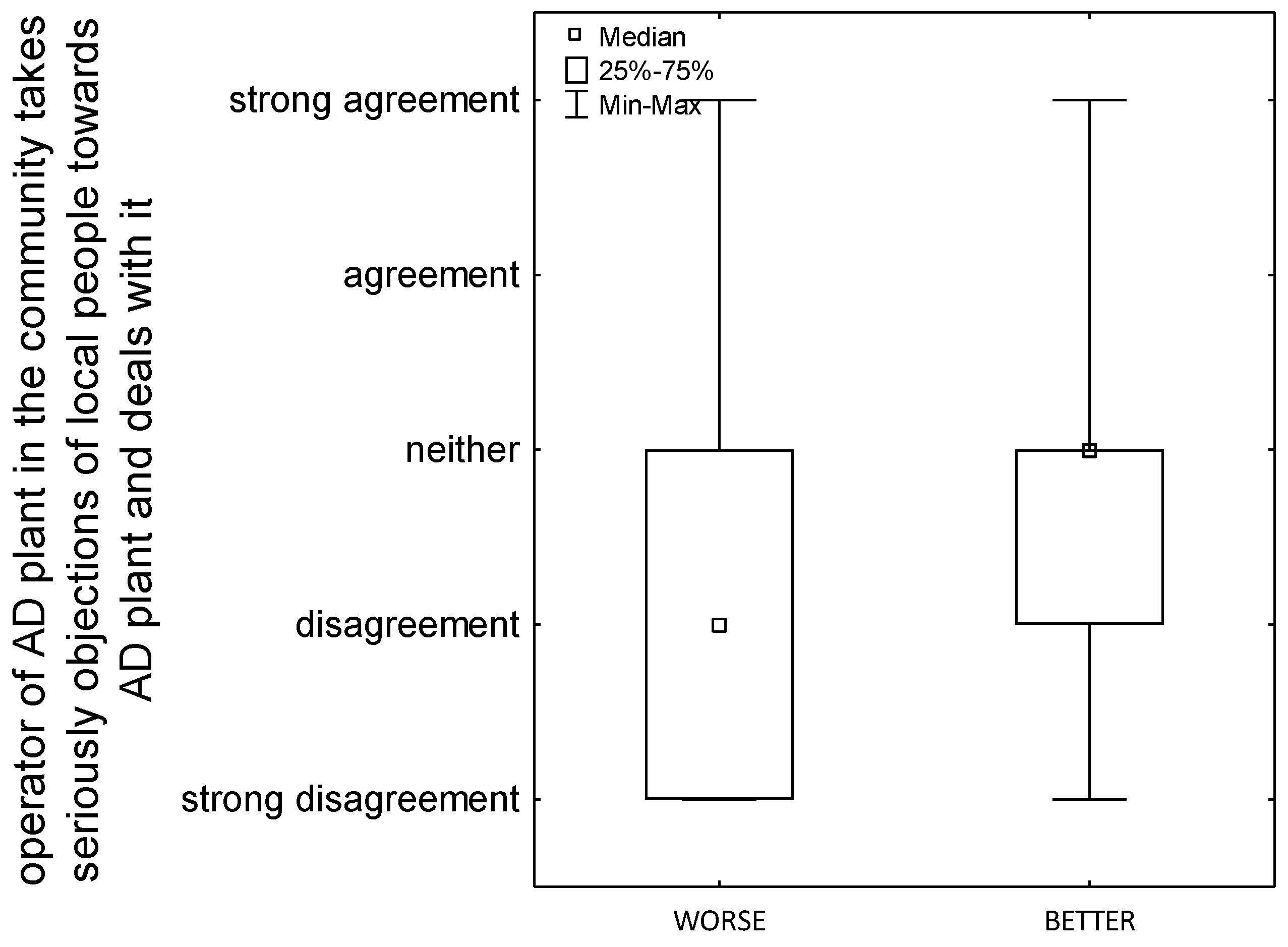
| Data | |
|---|---|
| Rather negative general perception of AD plants among rural population. | [14] |
| Real or perceived reduction in the quality of the environment around AD plants (including odor leakages and increased traffic). | [6] |
| Reduction in the attractiveness of the community for tourism. | [6] |
| Ethically controversial processing of purpose-grown energy crops grown on good-quality arable land in AD plants. | [26] |
| Displacement of food production away from farm-fed AD plants. | [26] |
| Changes in regional farming systems due to AD plant operations. | [26] |
| Impact on host communities and immediate neighborhoods. | [27] |
| Lack of awareness and limited knowledge of the anticipated impacts of AD plants on surrounding neighborhoods. | [28] |
| Lack of transparency and clarity in sharing information about AD plant projects. | [14] |
| Lack of participation by the local population in the planning phase. | [14,26,30,31] |
| Less attention to AD plants in the operational phase. | [20,32] |
| Data | WORSE Group (n = 56) | BETTER Group (n = 86) |
|---|---|---|
| gender (%) | ||
| female | 53.6 | 45.4 |
| male | 46.4 | 54.6 |
| age (mean in years) | 41.9 | 42.1 |
| level of education (%) | ||
| primary | 8.9 | 8.1 |
| secondary | 28.6 | 31.4 |
| secondary with leaving exam | 42.9 | 33.7 |
| tertiary | 19.4 | 26.7 |
| economic status (%) | ||
| businessperson | 17.8 | 11.6 |
| employee | 58.9 | 55.8 |
| parental leave | 7.1 | 5.8 |
| retiree | 10.1 | 17.4 |
| student | 1.8 | 8.1 |
| unemployed | 3.6 | 1.1 |
| Type III Likelihood Test | Test of All Effects | ||||||
|---|---|---|---|---|---|---|---|
| d.f. | Log-Likelihood | Chi-Square | p | d.f. | Wald Stat. | p | |
| Intercept | 1 | 1.628 | 0.202 | ||||
| How seriously the operator of an AD plant in the community takes objections by local people. | 1 | −88.153 | 10.655 | 0.001 | 1 | 9.609 | 0.002 |
| Number of activities undertaken by respondents before AD plant construction. | 1 | −89.580 | 13.511 | 0.000 | 1 | 9.917 | 0.002 |
| Estimate | 95.00% Lower CL | 95.00% Upper CL | S.E. of Estimate | |
|---|---|---|---|---|
| Intercept | 0.579 | −0.311 | 1.469 | 0.454 |
| How seriously the operator of an AD plant in the community takes objections by local people. | −0.585 | −0.954 | −0.215 | 0.189 |
| Number of activities undertaken by respondents before AD plant construction. | 0.760 | 0.287 | 1.233 | 0.241 |
| Odds Ratio | 95.00 Lower CL | 95.00 Upper CL | |
|---|---|---|---|
| How seriously the operator of an AD plant in the community takes objections by local people. | 0.557 | 0.385 | 0.807 |
| Number of activities undertaken by respondents before AD plant construction. | 2.139 | 1.332 | 3.432 |
Publisher’s Note: MDPI stays neutral with regard to jurisdictional claims in published maps and institutional affiliations. |
© 2022 by the authors. Licensee MDPI, Basel, Switzerland. This article is an open access article distributed under the terms and conditions of the Creative Commons Attribution (CC BY) license (https://creativecommons.org/licenses/by/4.0/).
Share and Cite
Martinát, S.; Chodkowska-Miszczuk, J.; Kulla, M.; Navrátil, J.; Klusáček, P.; Dvořák, P.; Novotný, L.; Krejčí, T.; Pregi, L.; Trojan, J.; et al. Best Practice Forever? Dynamics behind the Perception of Farm-Fed Anaerobic Digestion Plants in Rural Peripheries. Energies 2022, 15, 2533. https://doi.org/10.3390/en15072533
Martinát S, Chodkowska-Miszczuk J, Kulla M, Navrátil J, Klusáček P, Dvořák P, Novotný L, Krejčí T, Pregi L, Trojan J, et al. Best Practice Forever? Dynamics behind the Perception of Farm-Fed Anaerobic Digestion Plants in Rural Peripheries. Energies. 2022; 15(7):2533. https://doi.org/10.3390/en15072533
Chicago/Turabian StyleMartinát, Stanislav, Justyna Chodkowska-Miszczuk, Marián Kulla, Josef Navrátil, Petr Klusáček, Petr Dvořák, Ladislav Novotný, Tomáš Krejčí, Loránt Pregi, Jakub Trojan, and et al. 2022. "Best Practice Forever? Dynamics behind the Perception of Farm-Fed Anaerobic Digestion Plants in Rural Peripheries" Energies 15, no. 7: 2533. https://doi.org/10.3390/en15072533
APA StyleMartinát, S., Chodkowska-Miszczuk, J., Kulla, M., Navrátil, J., Klusáček, P., Dvořák, P., Novotný, L., Krejčí, T., Pregi, L., Trojan, J., & Frantál, B. (2022). Best Practice Forever? Dynamics behind the Perception of Farm-Fed Anaerobic Digestion Plants in Rural Peripheries. Energies, 15(7), 2533. https://doi.org/10.3390/en15072533








